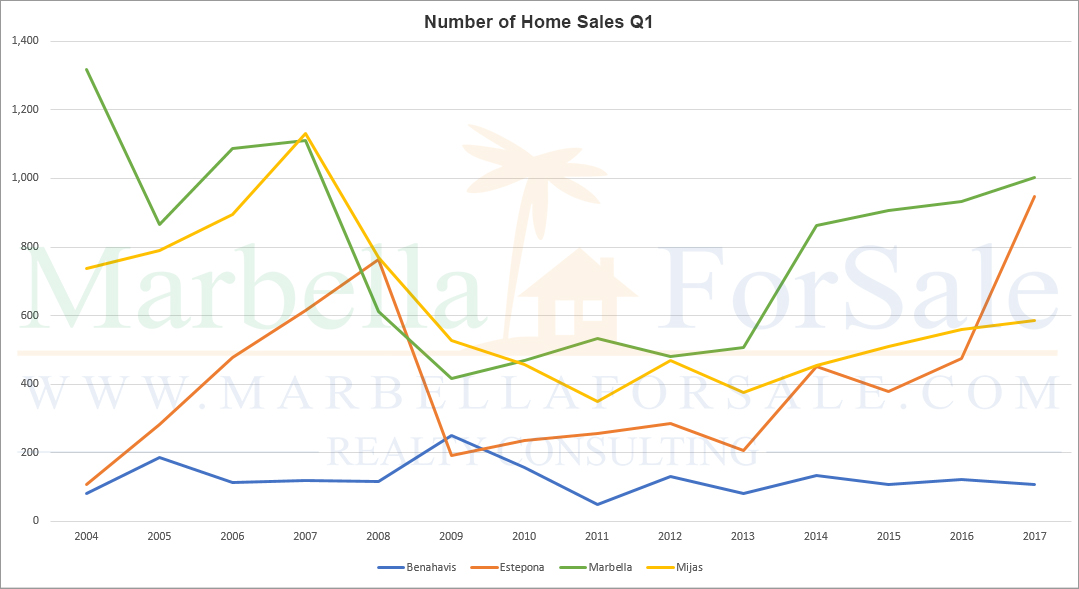
According to the latest figures from the INE, July saw a 16.8% increase in the number of homes sold in Spain, when compared to the previous year. So, has the market stabilised? Are sales back up to pre-crisis levels? To try and answer those questions we take a brief look at the Q1 sales results since 2004 in Estepona, Benahavís, Mijas and Marbella – four of the most popular areas on the Costa del Sol.
Some areas of the coast have now not only recovered from the financial crisis, but surpassed pre-crisis sales numbers, while others have remained stable.
Based on the financial crisis taking hold at the end of 2007, you would expect 2008, ’09, ’10 to be the worst years but it doesn’t seem so clear cut. For example, from ’07 to ’08 Estepona saw a big increase in sales, while Benahavís was almost unchanged. Marbella and Mijas however took a hit with their sales figures dropping significantly.
To 2009 Benahavís actually saw a significant increase while the other three areas continued to drop with Estepona seeing fewer than 200 sales for the first time since 2004. 2010 seemed to be a turning point for Estepona and Marbella with both seeing an increase in sales. However, the following year saw the lowest figures in Benahavís over the last 13 years. From 2012 it is almost all positive and therefore I would tentatively put forward 2012 as the year the Costa del Sol recovery began in earnest.

Estepona
Estepona has had a good start to 2017 with 946 home sales in the first quarter. Compare this to the 108 sold in 2004, or even the 616 sold in 2007 just before the crisis took hold. We see that the town has recorded its highest Q1 sales figures in 13 years. First-quarter sales figures in Estepona have increased year-on-year since the start of 2015 having been up and down for the preceding few years.
From 2010 to 2013 the results were quite stable with figures in the two-hundreds recorded each year. 2014 saw a leap with the number of Q1 sales more than doubling, compared to the previous year. A slight decline to 2015 preceded two years of increases.
Estepona has seen a lot of investment over recent years with government money cleaning up the old town and investing in the marina. The town, only 20 minutes from Marbella, is an “up-and-coming” area as far as real-estate is concerned. With prices typically 10-20% lower than in Marbella, Estepona is becoming a first-choice for many house hunters.
Benahavis
Q1 sales figures in Benahavis seem to have remained stable for the last 13 years with the exception of a peak in 2009 and a dip in 2011. Following the dip there appeared to be a recovery in 2012 which was short lived, dropping again in 2013. Since then, the numbers have always been above 100 with each year being only marginally different. This year has seen sales almost matching those of 2006/07 which were considered “boom” years.
The hillside town of Benahavís is expanding. There are a couple of new projects underway in the village and on the outskirts. It is a quiet town, great for retirement, but is always popular with tourists looking for real Spanish food or a tranquil walk in the hills. There is also a river that runs alongside the town which has waterfalls and plunge pools and always attracts the brave for a cool dip during the summer.
We must bear in mind that Benahavís is not only the small village but also includes areas such as La Quinta, Los Almendros, El Madroñal and La Zagaleta.
Mijas
Encompassing Mijas Costa and Mijas Pueblo, the town has seen a significant drop in the number of home sales since 2007. From 2004 sales numbers increased steadily only slowing when the crisis hit. In the first quarter of 2017 the town saw a little under half the number of sales seen ten years ago. Sales numbers fell year-on-year from 2007 through to 2011 with 2012 showing the first positive annual variation. Only since 2013 do the results begin to rise, followed by 4 consecutive annual increases.
With coastal property prices increasing at a faster rate than rural property, and a higher number of coastal properties on the market, demand is high and I would expect to see the sales figures continue to increase over the next few years in Mijas Costa with a slower yet consistent increase in the sale of property in Mijas Pueblo.
Marbella
Marbella has always been one of the most sought-after areas of the coast and the sales figures prove it. The only one of the four areas to see more than 1,000 sales in Q1 of this year, yet still lower than in 2007, the Marbella area is seeing a huge increase in the number of new developments under construction. Following a few years of little-to-no construction activity this year has seen the return of many cranes to the horizon. This is clearly going to fuel the increase in sales adding a surplus of property to an already saturated market. However, we see that sales in the town have increased every year since 2012 which shows that the resale market has also seen a resurgence in recent years.
With new property going up all the time and with an ever-expanding number of resale properties on the market, expect to see the sales figures for Marbella continuing to increase over the next few years. However, if the weak pound keeps falling there may be a further drop in sales to Brits, who still account for a large proportion of the total property sales across Spain.

Source: Fomento








